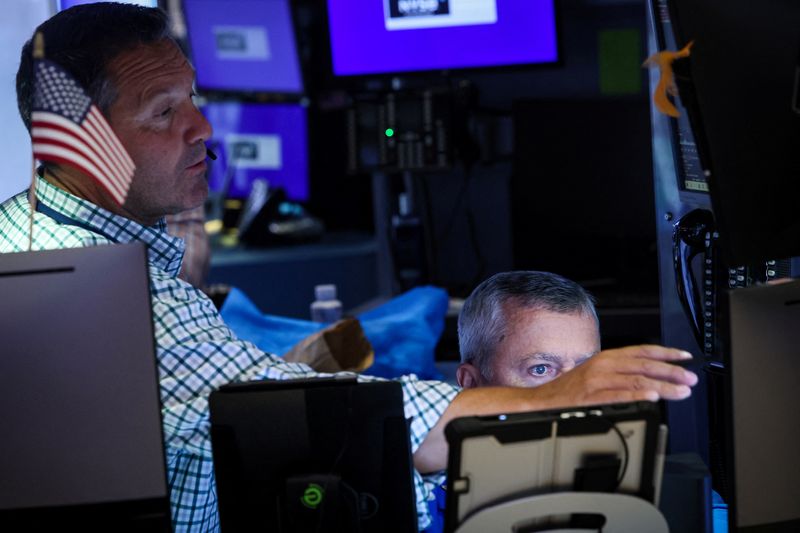Stephen Culp
NEW YORK (Reuters) – U.S. shares prolonged losses on Friday as ongoing disruption brought on by a software program glitch that triggered world expertise outages added uncertainty to an already anxious market.
The far-reaching expertise outage disrupted operations throughout industries together with airways, banks and healthcare after a software program glitch at cybersecurity agency Crowdstrike crashed Microsoft’s (NASDAQ: ) Home windows working system.
Whereas the flaw was found and a repair was deployed, technical points are nonetheless impacting some companies.
Crowdstrike shares fell 11.1%, whereas rival cybersecurity firms Palo Alto Networks (NASDAQ: ) and Sentinel One (NYSE: ) rose 2.2% and seven.8% respectively.
All three main U.S. inventory indexes ended decrease, with the Dow Jones Industrial Common falling essentially the most.
On a weekly foundation, each the Nasdaq and the Dow recorded their worst weeks since April, with the Dow hitting a collection of all-time closing highs earlier within the week, Friday-Friday rise.
“This technological disruption provides some uncertainty and places strain on the complete Nasdaq,” mentioned Robert Pavlik, senior portfolio supervisor at Dakota Wealth in Fairfield, Connecticut. ” However it will not have a lot of an general impression, not simply on summer time Fridays however (traders) are on the sidelines.”
“They have been sitting on the sidelines,” Pavlik added. “That is what occurs within the inventory market when volatility takes over.”
The CBOE Market Volatility Index, seen as a gauge of investor nervousness, hit its highest stage since late April.
Small-cap shares – beneficiaries of the current shift away from large-cap progress shares – ended barely decrease.
Shares of Nvidia (Nasdaq: NVIDIA) led the chip shares decrease. It underperformed the broader market, falling 3.1%.
Moreover, New York Fed President John Williams reiterated the central financial institution’s dedication to reducing inflation to its 2% goal.
Based on CME’s FedWatch instrument, monetary markets have priced in a 93.5% probability that the Fed will enter a fee lower section on the finish of its September assembly.
The S&P 500 Index fell 377.49 factors, or 0.93%, to 40,287.53 factors; the S&P 500 Index fell 39.59 factors, or 0.71%, to five,505 factors; the S&P 500 Index fell 144.28 factors, or 0.81%, to 17,7400 factors.
Of the 11 main sectors within the S&P 500, power shares have been the largest decliners, whereas well being care and utilities have been the one ones to achieve.
The second-quarter earnings season has concluded its first full week, with 70 firms within the S&P 500 reporting earnings. Based on LSEG, 83% of those forecasts exceeded consensus.
Analysts now anticipate S&P 500 earnings to rise 11.1% yearly, up from a July 1 forecast of 10.6%.
Subsequent week, Tesla (NASDAQ: ), Alphabet (NASDAQ: ), Worldwide Enterprise Machines Company (NYSE: ), Basic Motors (NYSE: ), Ford (NYSE: ) and plenty of others.
“It is early in earnings season, however issues are spectacular,” mentioned Ryan Detrick, chief market strategist at Carson Group in Omaha, Neb. “However massive firms will begin reporting subsequent week, and we What I wish to hear is how sturdy the buyer is and what the prospects for future financial progress are.”
Eli Lilly and Firm (NYSE: ) rose 1.0% after China permitted its weight-loss drug tezepatidide, whereas Intuitive Surgical (NASDAQ: ) rose 9.4% after better-than-expected second-quarter outcomes.
Vacationers (NYSE: ) fell 7.8% as web written premium progress fell wanting expectations.
Netflix (NASDAQ: ) fell 1.5% in uneven buying and selling after the streaming large warned third-quarter subscriber progress could be decrease than a 12 months earlier.
Oilfield companies supplier SLB rose 1.9% after posting sturdy second-quarter earnings.
Declining points outnumbered advancing ones on the NYSE by a 2.11-to-1 ratio; on Nasdaq, a 1.91-to-1 ratio favored decliners.

There have been 27 S&P 500 shares hitting new 52-week highs and 4 new lows; the Nasdaq hit 50 new highs and 99 new lows.
Quantity on U.S. exchanges was 10.54 billion shares, in contrast with the 11.72 billion share common for the complete session over the previous 20 buying and selling days.
